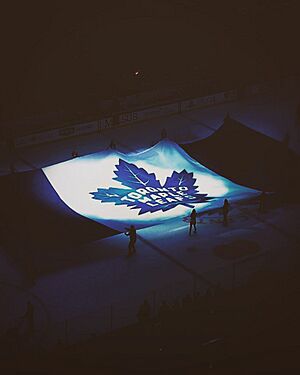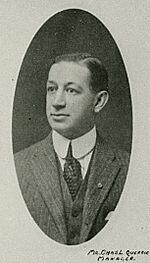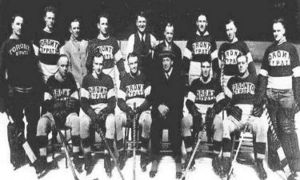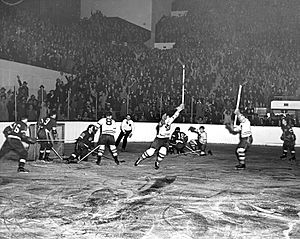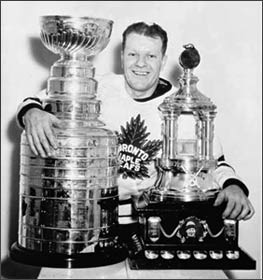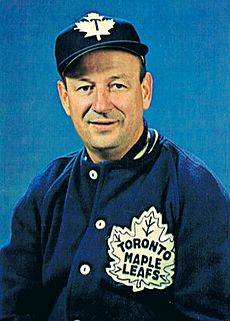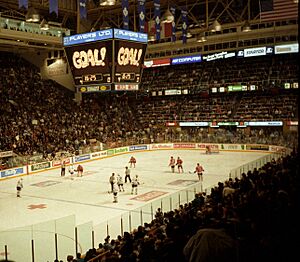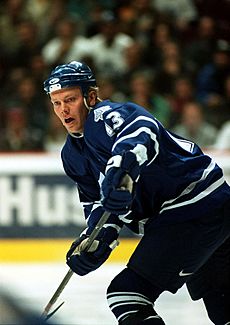History of the Toronto Maple Leafs facts for kids
The history of the Toronto Maple Leafs is all about a professional ice hockey team in the National Hockey League (NHL). The team and the NHL itself started because of disagreements between Eddie Livingstone, who owned the National Hockey Association's (NHA) Toronto Blueshirts, and other team owners.
In November 1917, these other owners created the NHL. They gave Toronto a temporary team. This team, called the Toronto Arenas, played at Arena Gardens. They won the 1918 Stanley Cup Finals in the NHL's very first season. The NHL made the team a permanent part of the league in October 1918.
In 1919, the team was sold and renamed the Toronto St. Patricks. The St. Patricks won one Stanley Cup in 1922. Later, the team was put up for sale again. Conn Smythe bought the team in 1927. He immediately changed the name to the Toronto Maple Leafs. To help build their new home, Maple Leaf Gardens, Smythe created a company called Maple Leaf Gardens Limited. The Maple Leafs played their first game at Maple Leaf Gardens in November 1931. In the 1930s, the team was led by a famous group of players called The Kid Line. This line helped the Maple Leafs win the 1932 Stanley Cup and reach the finals six more times.
During the Great Depression, many NHL teams struggled. By the 1942–43 season, the Maple Leafs were one of only six teams left in the league. The Maple Leafs were very successful in this "Original Six" era (until the 1966–67 season). They won the Stanley Cup in 1942, 1945, 1947, 1948, and 1949. After winning the 1951 Stanley Cup, the team didn't win another championship for 11 years. Before the 1961–62 NHL season, Conn Smythe sold most of his shares in the team to his son, Stafford Smythe, John Bassett, and Harold Ballard. The Maple Leafs then found new success in the 1960s, winning the Stanley Cup in 1962, 1963, 1964, and 1967. Their last championship was in 1967. The Maple Leafs currently have the longest active drought without winning the Stanley Cup in the NHL.
In 1971, Harold Ballard became the main owner. In the 1970s, the Maple Leafs did fairly well, missing the playoffs only once. However, the team didn't have a winning record for 12 years, from 1980–81 to 1992–93. In the 1990s and early 2000s, the team became competitive again. They missed the playoffs only twice from 1993 to 2004. In February 1999, the Maple Leafs moved from Maple Leaf Gardens to their new home, the Air Canada Centre. After the 2004–05 NHL lockout, the Maple Leafs had a seven-year playoff drought, not making the playoffs from 2006 to 2013 Stanley Cup playoffs. In August 2012, BCE Inc. and Rogers Communications bought a large part of the team's ownership. Shortly after the 2013–14 season, Brendan Shanahan became the president of the hockey club.
Contents
How the Leafs Began (1917–1928)
The Toronto Maple Leafs team started because of problems between Eddie Livingstone, who owned the Toronto Blueshirts in the National Hockey Association (NHA), and other NHA team owners. The owners wanted to create a new league without Livingstone.
In November 1917, the owners of the Montreal Canadiens, Montreal Wanderers, and Ottawa Senators met. They decided to start a new league called the National Hockey League. They gave a temporary team to the Arena Gardens of Toronto, Limited. This group owned the Arena Gardens where the Blueshirts used to play. The new Toronto team was meant to be temporary for the first season. The NHL wanted the Arena Company to sort out their issues with Livingstone. The team was allowed to use the Blueshirts' players for the season.
The Maple Leafs do not count the Blueshirts' history as their own. However, they do count the history of the "temporary" Toronto team from 1917–18.
Toronto Arenas: First NHL Team (1917–1919)
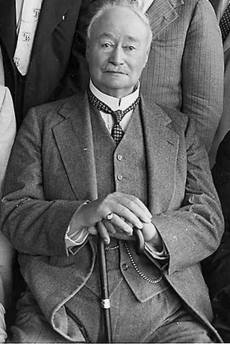
The Toronto team didn't have an official name in the NHL's first season. Newspapers sometimes called them "the Blueshirts" or "the Torontos." The team was managed by Charles Querrie and coached by Dick Carroll. They won the Stanley Cup that season! There was a disagreement about money from the Stanley Cup games. Because of this, the Toronto club didn't engrave their name on the Cup at the time. In 1948, the NHL finally added "1918 Toronto Arenas" to the Cup.
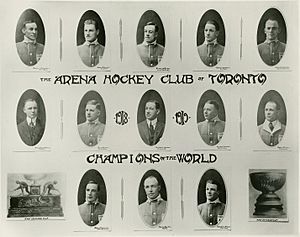
Since the Torontos won the Cup, even more money was involved. The team was worth a lot, and Livingstone wanted a big payment. The Arena Company offered less. This led to more legal issues. The old NHA league was eventually shut down. The Arena Company then asked for a permanent team. This new team, the Toronto Arena Hockey Club, was known as the Toronto Arenas. It was separate from the Arena Company's other business. The Arenas still used Livingstone's players without his full permission.
The legal issues cost the Arenas a lot of money. They had to sell most of their best players. This led to a very bad season in 1918–19, with only five wins. The team was losing money. They asked to stop playing for the season in February 1919. The league president, Frank Calder, convinced them to play one more game. Then, the league ended the regular season early and started the playoffs. The Arenas' winning percentage that season is still the worst in the team's history. The 1919 Stanley Cup Finals ended without a winner, so the Arenas said they were world champions by default.
Toronto St. Patricks: A New Name (1919–1927)
In 1919, Charles Querrie, the general manager, learned that the Arena Company wanted to sell the team. Querrie changed the team name to the Tecumsehs temporarily. The next day, Querrie agreed to sell the team to the amateur St. Patrick's club. The NHL approved the sale in December 1919. The new owners renamed the team the Toronto St. Patricks (or St. Pats). They also changed the team's colors from blue to green.
The 1921–22 NHL season was when the St. Pats won their only Stanley Cup. The team finished second to the Ottawa Senators. But they played great in the playoffs! The St. Pats beat the Senators. Then, they traveled to Vancouver to play the Millionaires. They won the series and the Cup! The team's star was Babe Dye, who scored 11 goals in 7 playoff games. Goalie John Ross Roach had two shutouts.
For the next two seasons, the St. Pats didn't make the playoffs. In 1924–25, they qualified for the playoffs again. They lost to the Montreal Canadiens. The St. Pats didn't make the playoffs in the next two seasons.
Conn Smythe Takes Over (1927–1961)
The team's owner, Charles Querrie, decided to sell the St. Pats. He almost sold them to a group that wanted to move the team to Philadelphia. But Conn Smythe stepped in. Smythe convinced Querrie that keeping the team in Toronto was more important. Smythe put together a group that bought the St. Pats. Smythe himself invested his own money.
After taking control in February 1927, Smythe immediately renamed the team the Maple Leafs. The Toronto Maple Leafs baseball team had been using that name for 30 years. Smythe said he chose the name to honor the Maple Leaf Regiment from World War I. Another story says he named the team after a junior team he had scouted.
Smythe became the team's general manager. He was the main person in charge for the next 34 years. At first, reports said the team's colors would be red and white. But the Leafs wore white jerseys with a green maple leaf for their first game on February 17, 1927. On September 27, 1927, the Leafs announced they changed their colors to blue and white. They have worn these colors ever since. The Leafs say blue represents the Canadian skies and white represents snow.
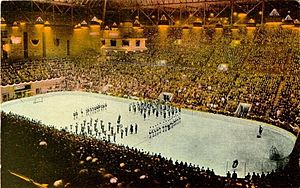
After a few more difficult seasons, Smythe saw how popular the team was becoming. He realized they needed a new arena. He bought land and built Maple Leaf Gardens in just five months. The Leafs played their first game at their new arena on November 12, 1931. They lost 2–1 to the Chicago Blackhawks. The "Kid Line" (Busher Jackson, Joe Primeau, and Charlie Conacher) and coach Dick Irvin led the Leafs to win their third Stanley Cup in their first season in the new building. They won the Cup in 1932. Smythe was especially happy to beat the New York Rangers that year. He had been the Rangers' first general manager but was fired earlier.
In 1933, Leafs star forward Ace Bailey was badly injured. His career ended. The Leafs reached the finals five more times in the next seven years but didn't win. After the 1940 loss, Smythe hired former Leafs captain Hap Day as coach.
In 1942, Toronto was down three games to none in the best-of-seven finals against Detroit. But fourth-line forward Don Metz helped spark the team. He scored a hat-trick in game four and the winning goal in game five. The Leafs won both times. Captain Syl Apps had won an award that season for not taking any penalties. Goalie Turk Broda shut out the Wings in game six. Sweeney Schriner scored two goals in the third period to win game seven 3–1 and the Stanley Cup. No other team has come back from being down 3–0 in a Stanley Cup Finals since.
Three years later, many of the 1942 heroes were gone. The Leafs relied on newer players like rookie goalie Frank McCool and defenceman Babe Pratt. They upset the Red Wings in the 1945 finals. In the 1946-47 NHL season, Maple Leaf Gardens was the first arena in the NHL to have clear plastic (Plexiglas) in the end zones of the rink.
The strong Montreal Canadiens and their "Punch Line" were the Leafs' rivals in the 1947 finals. Ted "Teeder" Kennedy scored the winning goal late in game six. This gave the Leafs their first of three straight Cups. No NHL team had done that before! With their Cup win in 1948, the Leafs had won more Stanley Cups than Montreal.
The Maple Leafs and Canadiens met again in the 1951 finals. Five games in the series went into overtime. Defenceman Bill Barilko scored the winning goal in overtime. Barilko helped the team win its fourth Stanley Cup in five years. Sadly, he disappeared in a plane crash four months later. The crash site was not found for eleven years. The Leafs didn't win another Cup in the 1950s. Some people rumored that the team was "cursed" and wouldn't win until Barilko's body was found. The "curse" ended after the Leafs' 1962 Stanley Cup victory, which happened six weeks before Barilko's plane was found.
After their 1951 win, the team didn't play as well. They finished third in the 1951–52 season and were swept by the Red Wings in the semi-finals. In 1952–53, the Leafs missed the playoffs for the first time in several years. This might have been because their junior player development system wasn't producing as many good players. It took a few years for the Leafs to get competitive again.
After two years out of the playoffs, the Maple Leafs made it back in the 1958–59 season. Under Punch Imlach, their new general manager and coach, the Leafs reached the 1959 Finals. They lost to the Canadiens. The next season, 1959–60, the Leafs finished second. They reached their second straight Cup Finals but were again defeated by the Canadiens.
New Owners, New Success (1961–1972)
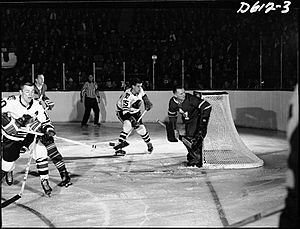
For a long time, Toronto couldn't match their Cup-winning teams from the 1940s and 1951. Stronger teams like Detroit and Montreal won the Cup year after year. The Leafs didn't win another Stanley Cup until 1962.
Before the 1961–62 season, Smythe sold most of his shares in Maple Leaf Gardens. His son Stafford Smythe, newspaper owner John Bassett, and Toronto Marlboros president Harold Ballard bought them. This gave the three of them control of about 60% of the Leafs and Gardens.
Then, Toronto won three straight Stanley Cups from 1962 to 1964! They had amazing players like Frank Mahovlich, Red Kelly, Johnny Bower, Dave Keon, Andy Bathgate, and Tim Horton. Coach and general manager Punch Imlach led the team.
In 1967, the Leafs and Canadiens met in the Cup Finals for the last time. Many thought Montreal would easily win because the Leafs were considered older players. But Bob Pulford scored the winning goal in game three. Jim Pappin scored the series winner in game six. Dave Keon won the Conn Smythe Trophy as the playoffs' Most Valuable Player. The Maple Leafs won the Stanley Cup in six games! The Leafs have not won the Stanley Cup or even reached the finals since then.
The next two seasons saw many changes to the team. Imlach made these changes because he didn't like the new Players' Association. The Leafs missed the playoffs in 1968. After that, Mahovlich was traded. They returned to the playoffs in 1969 but lost badly in the first round. Smythe then fired Imlach.
The Ballard Years (1972–1990)
After Stafford Smythe passed away, Harold Ballard bought his shares. Ballard took control of the team in February 1972. Stafford Smythe's brother also sold his shares to Ballard. This ended the Smythe family's 45-year involvement with the NHL team.
Ballard traded away many of the team's most popular players. He also stopped Dave Keon from signing with another NHL team when his contract ended in 1975. This forced Keon to play in another league. Ballard believed the Leafs would still sell out games no matter how well the team played. He didn't want to spend more money than needed to make a profit.
In the 1970s, the league had more teams, and a rival league started. This spread out the talent. The Leafs, led by stars like Darryl Sittler, Lanny McDonald, enforcer Tiger Williams, Ian Turnbull, and Borje Salming, were competitive for several seasons. On February 7, 1976, Sittler scored six goals and four assists against the Bruins. This set an NHL record for most points in a single game, which still stands today. On February 2, 1977, Toronto Maple Leafs defenceman Ian Turnbull was the first player in NHL history to score five goals on five shots. Despite these great performances, the Leafs couldn't reach the Stanley Cup Finals. They only made it past the second round of the playoffs once.
In July 1979, Ballard brought his friend Punch Imlach back as general manager. The Leafs traded McDonald, a close friend of Sittler, in December 1979. Some believed this was to weaken Sittler's influence on the team. Sittler and other Leafs players were asking for better contracts. Angry teammates damaged their dressing room. Sittler temporarily gave up his captaincy. Sittler himself was traded two years later. He left as the team's all-time leading scorer.
The McDonald trade made the Leafs' performance worse. They finished with a losing record. They only made the playoffs because of the way the divisions were set up. Ballard had actually been against adding more teams to the NHL. He felt it reduced the Leafs' TV money.
For the next 12 years, the Leafs were rarely competitive. They didn't have another winning record until 1992–93. They missed the playoffs six times. They only finished higher than fourth in their division once. The lowest point was in 1984–85, when they had the second-worst record in team history.
Many times, they made the playoffs with very bad records. For example, in 1985-86, they had the fourth-worst record in the league. However, their division was very weak. The top four teams in each division made the playoffs, no matter their record. The Leafs made the playoffs and even won their first series before losing.
In 1987–88, they had the second-worst record in the league. But their division was even weaker. The Leafs still made the playoffs. Many fans think Ballard's time as owner was the worst period in team history. They only had six winning seasons during his 18 years as owner. The Leafs' poor performance led some to call them the "Maple Laughs."
The Leafs' bad records meant they got several high draft picks. Wendel Clark, chosen first overall in the 1985 draft, later became the team captain.
A New Beginning (1990–2004)
Ballard passed away in 1990. A year later, Steve Stavro, a friend of Ballard's, bought the team from Ballard's estate. Stavro didn't like being in the spotlight and rarely got involved in the team's hockey decisions.
After 1991–92, former Calgary Flames general manager Cliff Fletcher took over the team. He made many trades and signed free agents. This quickly turned the Leafs into a strong team. Unlike other Canadian teams, the Leafs were not badly affected by rising player salaries. They actually did well because they were in a large market.
The new stars helped the team almost immediately in 1992–93. Doug Gilmour, who came from the Flames, scored 32 goals and 95 assists. He led the team in scoring. Dave Andreychuk joined the Leafs and scored 25 goals in his first 31 games. Goalie Felix Potvin was also strong with a great goals-against average. Toronto finished with a team-record 99 points. They beat the Detroit Red Wings in the first round. Then, they won their division final by defeating the St. Louis Blues.
Many Canadians hoped for a Montreal–Toronto Cup Finals. The Leafs faced the Los Angeles Kings, led by Wayne Gretzky, in the conference final. The Leafs were up 3–2 in the series. But they lost game six. Gretzky's hat-trick in game seven ended the Leafs' run. The Kings moved on to the Finals.
The Leafs had another strong season in 1993–94, finishing with 98 points. This was their best overall finish in 16 years. However, they lost to the Vancouver Canucks in five games in the playoffs.
The Maple Leafs moved arenas in the middle of the 1998-99 season. On February 13, 1999, the Maple Leafs played their last game at Maple Leaf Gardens. They lost 6–2 to the Chicago Blackhawks. The first Maple Leafs game at the new Air Canada Centre was on February 20, 1999, against the Montreal Canadiens. They won 3–2 in overtime.
After two years out of the playoffs, the Leafs made another strong push in the 1999 playoffs. Mats Sundin, who joined the team in 1994, had one of his best seasons. Sergei Berezin scored 37 goals. Curtis Joseph won 35 games. The Leafs eliminated the Philadelphia Flyers and Pittsburgh Penguins in the first two rounds. But they lost to the Buffalo Sabres in the Eastern Conference Finals.
The Maple Leafs reached the second round in both 2000 and 2001. They lost both times to the New Jersey Devils. The 2000 season was special because it was the Leafs' first division title in 37 years. It was also the team's first time getting 100 points in a season.
In 2002, they beat the Islanders and their rivals, the Ottawa Senators, in the first two rounds. But they lost to the Cinderella-story Carolina Hurricanes in the Conference Finals. The 2002 season was impressive because many of the Leafs' best players were injured. But they still made it to the conference finals thanks to players like Gary Roberts.
Joseph left to join the Red Wings in 2002. The team quickly found a replacement in veteran goalie Ed Belfour. Belfour couldn't help them in the 2003 playoffs, as they lost to Philadelphia in seven games in the first round. The 2003–04 season started in a unique way. The team held their training camp in Sweden and played games against Swedish and Finnish teams. That year, the Leafs set a team record with 103 points. They also had their best overall finish in 41 years. They beat the Senators in the first round of the playoffs for the fourth time in five years. But they lost to the Flyers in the second round.
After the Lockout (2005–2014)
After the 2004–05 NHL lockout, the Maple Leafs had their longest playoff drought in team history. They struggled in the 2005–06 season. Even with a strong finish, they missed the playoffs. This was the first time the team had missed the playoffs since 1998. Their coach, Pat Quinn, was later fired.
Paul Maurice, who coached the Maple Leafs' farm team, the Toronto Marlies, became the new head coach. On June 30, 2006, the Leafs ended fan-favorite Tie Domi's contract. They also decided not to keep goalie Ed Belfour.
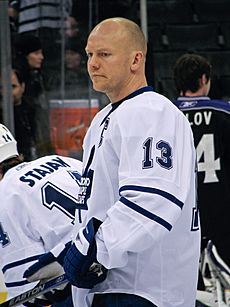
Despite the coaching change and roster changes, the team didn't make the playoffs in 2006–07. During the 2007–08 season, general manager John Ferguson, Jr. was fired. Cliff Fletcher took over temporarily. The Leafs didn't make the playoffs again. This was the first time since 1928 that the team missed the playoffs for three seasons in a row. It was also Mats Sundin's last year with the Leafs. He chose not to let the team trade him, hoping they could still make the playoffs. On May 7, 2008, the Leafs fired Maurice and hired Ron Wilson as the new head coach.
Sundin eventually signed with the Vancouver Canucks. He said he wanted a chance to win the Stanley Cup. Toronto played Vancouver twice in the 2008–2009 season. Sundin was honored at the Air Canada Centre and scored the winning goal against Toronto.
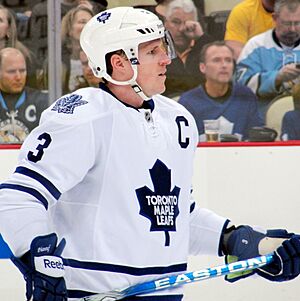
On November 29, 2008, the Maple Leafs hired Brian Burke as their new general manager. On June 26, 2009, Burke picked Nazem Kadri with the seventh overall pick in the draft. On September 18, 2009, Burke traded draft picks to the Boston Bruins for forward Phil Kessel. On January 31, 2010, the Leafs made another big trade. They got defenceman Dion Phaneuf from the Calgary Flames. The Maple Leafs finished 29th in the NHL in 2009–10.
On June 14, Phaneuf was named captain after two seasons without one. On February 18, 2011, the team traded long-time defenceman Tomas Kaberle to the Bruins. The Leafs, led by rookie goalie James Reimer, almost made the 2011 playoffs but missed by six points.
The 2011–12 season had high hopes for the Leafs. Kessel and Joffrey Lupul played well, and Toronto had a good start. But they couldn't keep it up and missed the playoffs. On March 2, 2012, Burke fired Wilson and named Randy Carlyle the new head coach. Changes in ownership happened in August 2012. BCE Inc. and Rogers Communications bought the shares in the team. On June 23, 2012, Burke traded defenceman Luke Schenn for James van Riemsdyk, who played well for Toronto for six seasons. On January 9, 2013, Burke was fired and Dave Nonis replaced him.
In their first full season under Carlyle, Toronto made the playoffs in the 2012–13 season (which was shorter due to another lockout). This was their first time in eight years. They were down 3–1 in their first-round series against the Boston Bruins. The Maple Leafs fought back to win Games 5 and 6. But they lost Game 7 after losing a 4–1 lead in the third period. They lost 5–4 in overtime. Despite this success, they didn't repeat it in the 2013–14 season and missed the playoffs.
The Brendan Shanahan Era (2014–Present)
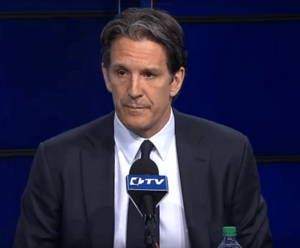
Shortly after the 2013–14 season, Brendan Shanahan became the president of the Maple Leafs. On January 6, 2015, the Leafs fired Randy Carlyle as head coach. Assistant coach Peter Horachek took over temporarily. The Leafs had a winning record before Carlyle was fired, but the team later struggled. On February 6, 2015, the Leafs set a new team record of 11 games in a row without a win. Shanahan decided to rebuild the team. Both Dave Nonis and Horachek were fired on April 12, the day after the season ended. Many assistant coaches and scouts were also let go.
On May 20, 2015, Mike Babcock was named the new head coach. On June 23, Lou Lamoriello became the 16th general manager. On July 1, 2015, the Leafs traded Kessel to the Pittsburgh Penguins. They got three players, including Kasperi Kapanen, and draft picks. Toronto also kept some of Kessel's salary. The next season, on February 9, 2016, the Leafs traded Phaneuf to the Ottawa Senators. They got four players and a draft pick. The team finished last in the NHL for the first time since the 1984–85 season. They won the draft lottery and used the first overall pick to draft Auston Matthews.
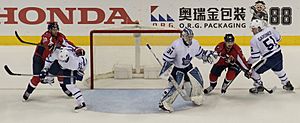
In their second season under Babcock, Toronto earned a playoff spot for the 2017 playoffs. On April 23, 2017, the Maple Leafs were eliminated by the top-seeded Washington Capitals. The Capitals won 2–1 in overtime in the sixth game. Toronto finished the 2017–18 season with a team-record 105 points. They beat their previous record of 103 points set in 2004. They faced the Boston Bruins in the first round and lost in seven games.
After the playoffs, Lamoriello was moved to a senior advisor role. Kyle Dubas was then named the 17th general manager. In 2018, the Maple Leafs signed John Tavares to a seven-year contract. Tavares was later named an alternate captain. On April 1, the Maple Leafs secured a playoff spot for the 2019 Stanley Cup playoffs. They were eliminated in the first round on April 23, after losing to the Bruins in a seven-game series.
On October 2, 2019, Tavares was named the team's 25th captain. On November 20, 2019, Shanahan and the Leafs announced that Babcock was fired as head coach. This happened after the team had a six-game losing streak. Babcock was replaced by Calder Cup-winning Toronto Marlies' head coach Sheldon Keefe. That year, the Maple Leafs were eliminated in the 2020 Stanley Cup Qualifiers on August 9. They lost a five-game series against the Columbus Blue Jackets.
Because of the COVID-19 pandemic and travel rules, the Leafs were temporarily moved to the North Division for the 2020–21 season. They played only against other Canadian teams in a shorter 56-game season. On May 8, 2021, the Leafs won the North Division title. This gave them home advantage in the first two rounds of the 2021 Stanley Cup playoffs. Matthews also led the league in goals, becoming the first Maple Leaf to win the Maurice "Rocket" Richard Trophy. However, the Leafs lost in the first round to the Montreal Canadiens. They gave up a 3–1 series lead.
Despite the tough ending to the previous season, the Maple Leafs seemed ready for another strong run. The main team stayed mostly the same. They added goalie Carter Hutton and defenceman Mark Giordano and center Colin Blackwell. The team played well throughout the regular season. The Leafs broke their team record for points in a season with 115 and wins in a season with 54. This happened during a 4–2 win over the New York Islanders on April 17. Even with this achievement, they couldn't beat the Florida Panthers, who won the division and had the best record in the NHL. The Leafs made the playoffs but lost in the first round to the Tampa Bay Lightning in seven games.
|
See also
- History of the National Hockey League
- List of Toronto Maple Leafs draft picks
- List of Toronto Maple Leafs general managers
- List of Toronto Maple Leafs head coaches
- List of Toronto Maple Leafs players
- List of Toronto Maple Leafs seasons


